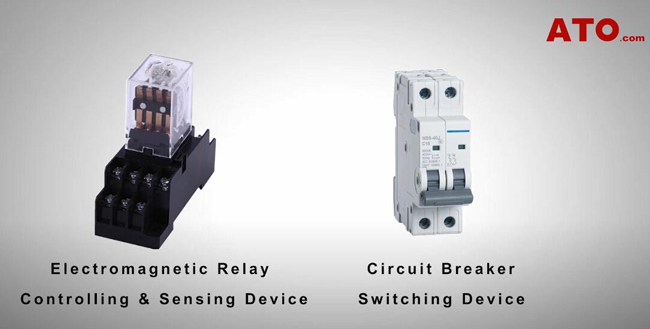Difference Between Relay and Circuit Breaker
In power systems, switches allow the system operators to disconnect or connect electrical circuits. Switches come in various configurations among which there are several specialized forms, such as relays and circuit breakers. Though in more precise terms, relays are controlling devices while circuit breakers are switching devices.
Relays and circuit breakers are two commonly used devices to disconnect a circuit. Both devices are able to stop currents flowing through the circuit. That being said, there are many differences between a relay and a circuit breaker.
A relay is an electronically or electromagnetically operated switch that is used as a sensing and controlling device to drive much larger electric loads via small electric signals. They can also regulate the direction of the current. Protective relays can prevent apparatus damage by sensing fault conditions including overcurrent, undercurrent, overloads and reverse currents and send signals to circuit breakers which make decisions to make or break the circuit based on the information provided by the relay.
An automated circuit breaker is an isolating or disconnecting device designed to protect an electrical circuit from damage caused by excessive currents, like overload and short-circuit conditions. It opens a circuit as soon as the current climbs to unsafe levels and can be used repeatedly. It is an automatic and manual device that may work on both low and high power and voltage levels. They themselves utilize relays to detect the fault or large current changes. If the relay detects a short circuit, overload or any other electrical abnormality, the relay will activate the trip circuit and cause a breaker operation. To conclude, there may be a relay in a circuit breaker, but a relay can’t be a circuit breaker.

Realy vs. Circuit Breaker
Here is a comparison chart that describes the difference between a circuit breaker and relay by considering several factors like construction, function, working principle, type of device they are, voltage level, the number of circuits they can control, and whether it works as an amplifier or not.
|
Characteristic |
Circuit Breaker |
Relay |
|
Construction |
A circuit breaker is a combination of an internal electromechanical switch and a relay mechanism that interrupts the circuit in case of a short circuit or overload. |
The coil inside a relay creates an electromagnetic field while the solenoid as a moving part known as the armature opens and closes the contacts when the coil is energized. |
|
Function |
A circuit breaker provides interruption only. Fault detection is performed by a relay inside the circuit breaker. |
A relay is a switching device that opens and closes the contacts electronically or electromechanically. |
|
Working Principle |
A circuit breaker automatically breaks the connected circuit when it receives an error signal sensed by a relay inside CB. |
A relay is a switching device used in the power system for providing signals to the circuit breaker as soon as a fault occurs in the system. |
|
Characteristic |
Circuit Breaker |
Relay |
|
Type of Device |
Circuit breaker is a type of disconnecting and isolating device. |
Relay is a sensing and controlling device. |
|
Voltage Level |
A circuit breaker operates on low as well as high power and voltage level and acts automatically on load devices. |
A relay operates on low power and voltage input signal with guaranteed isolation when needed for operation. |
|
Number of Circuits Controlled |
The circuit breaker can be used to control a single circuit, just like a switch. |
The relay can operate one or more circuits at a time. |
|
Characteristic |
Circuit Breaker |
Relay |
|
Used as an Amplifier |
A circuit is not capable of amplifying any signal. |
A relay can amplify discrete signals. |
|
Applications |
|
|
The study of protection in power systems is incomplete without the study of relays and circuit breakers. In spite of the differences, relays and circuit breakers are both the primary protective devices used in industrial as well as commercial applications. Having a more comprehensive understanding of their respective characteristics will definitely enable you to make wiser use of them in your daily life. There are more different types of relays and circuit breakers on ATO.com.
Please watch the following video to find out more differences between them.

